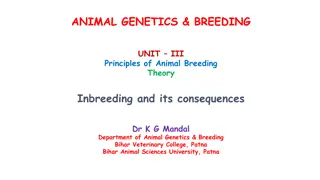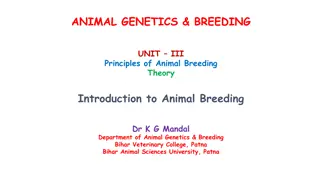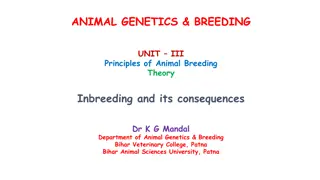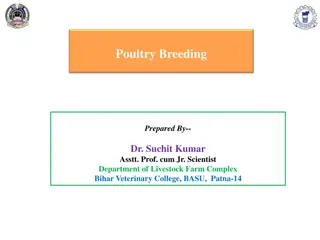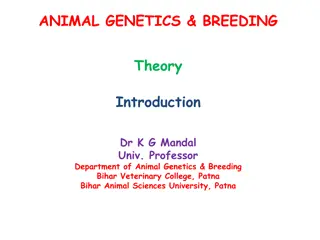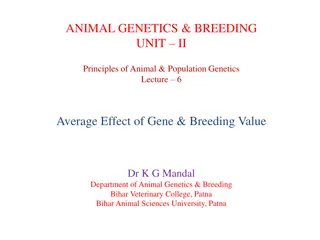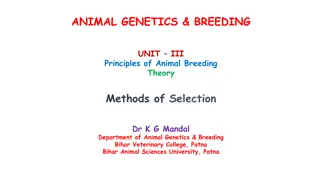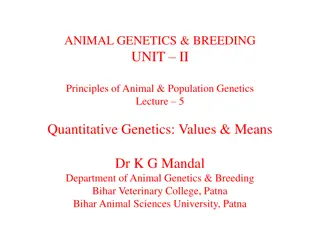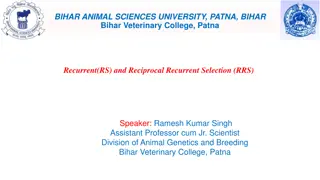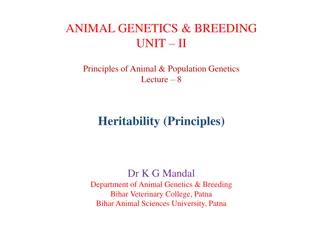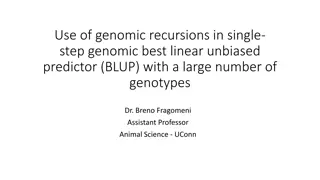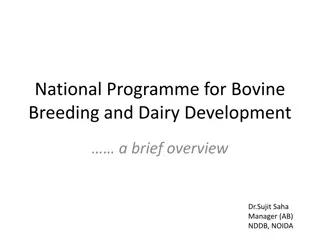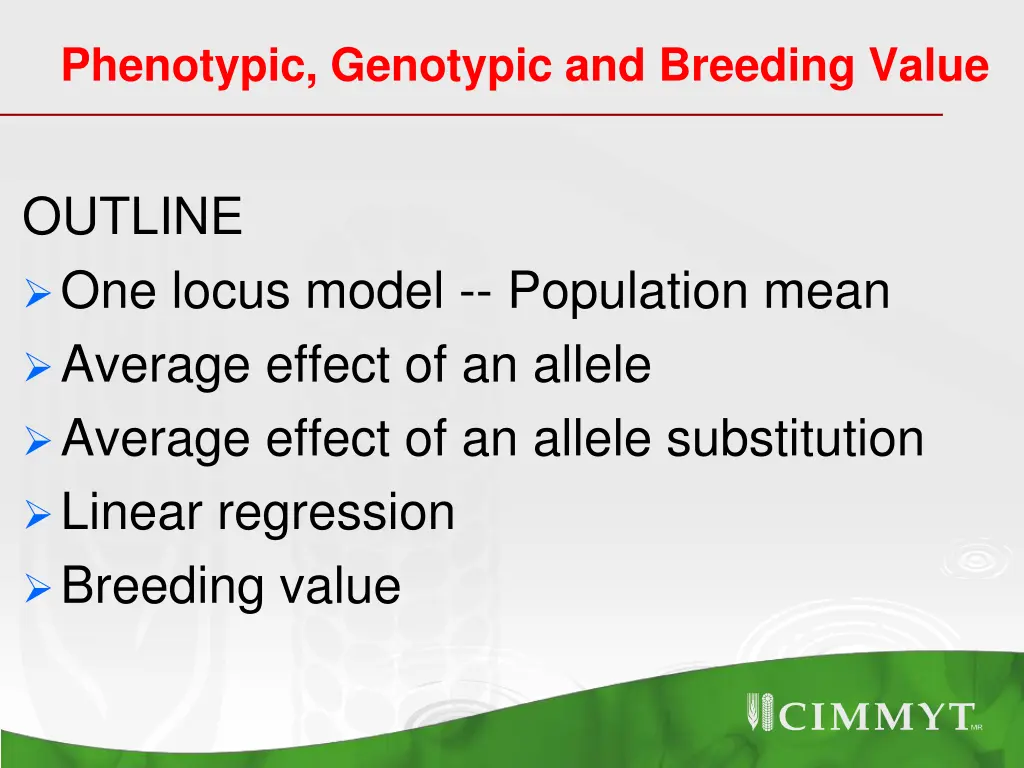
Understanding Phenotypic, Genotypic, and Breeding Values in One-Locus Model
Explore the concepts of phenotypic, genotypic, and breeding values in a one-locus model. Learn about average allelic effects, linear regression, additive and dominance effects, population mean calculations, and more in the context of genetic studies and breeding programs.
Download Presentation

Please find below an Image/Link to download the presentation.
The content on the website is provided AS IS for your information and personal use only. It may not be sold, licensed, or shared on other websites without obtaining consent from the author. If you encounter any issues during the download, it is possible that the publisher has removed the file from their server.
You are allowed to download the files provided on this website for personal or commercial use, subject to the condition that they are used lawfully. All files are the property of their respective owners.
The content on the website is provided AS IS for your information and personal use only. It may not be sold, licensed, or shared on other websites without obtaining consent from the author.
E N D
Presentation Transcript
Phenotypic, Genotypic and Breeding Value OUTLINE One locus model -- Population mean Average effect of an allele Average effect of an allele substitution Linear regression Breeding value
Phenotypic and Genotypic values Genotypic values can be estimated from phenotypic values Suppose a group of individuals all having genotype AiAj. The phenotype of one individual kthwith genotype AiAjis Pij(k)=Gij+eij(k) Pij(k)= +gij+eij(k) [gij=Gij- dev from the population mean] Cov(Gij,eij(k))=0 (weaker plants do not receive more nutrients)
One Locus model Additive and Dominance effects GENOTYPE A2A2 A1A2 A1A1 Z+a Genotypic value Genotypic value Z+a+d MP+d Z+2a MP+a Z MP-a MP Coded genotypic a -a 0 d MP=MID-PARENT=(A2A2+A1A1)/2=(Z+Z+2a)/2=Z+a a=[(Z+2a)-Z]/2 half the difference between the genotypic values of the two homozygous a=additive effect of a locus d=level of dominance d=a complete dominance d=0=1/2(a-a) No dominance 0<d<a Partial dominance d>a Overdominance
Population mean one locus model Assume one-locus in HW Genotype Freq. A1A1 A1A2 2pq A2A2 q2 Midparent value=MP=[Z+(Z+2a)]/2=Z+a Genotypic Coded value p2 Z+2a Z+a+d Z Genotypic value (Z+2a)-MP =a (Z+a+d)-MP =d Z-MP = -a
Population mean one locus model Mean of a population in HW = p2(Z+2a) + 2pq(Z+a+d) + q2(Z) = MP+ a(p-q) +2pqd Contribution homozygous Population mean more than one locus model + i i Contribution heterozygous i + MP a d ( - ) 2 p q pq = (The ith locus)
When d=0 (no dominance) - MP = a(1-2q) The mean is proportional to the alelle frequency [where a(1-2q)=a(p+q-2q)=a(p-q)] When d=a (complete dominance) - MP = a(1-2q2) The mean is proportional to the squared of the alelle frequency
Parents pass on alleles not their genotypes A new measure is needed that must refer to genes not to genotypes a, d and a are function of genotypes rather than of alleles How to express the effect of individual alleles? What is the effect of an allele? Can we express THE ALLELE EFFECT ON THE MEAN OF THE INDIVIDUALS THAT INHERIT THAT ALLELE?
Fisher formulated the Average effect of an allele Averaged effect of an allele on what? on the mean of the individuals that inherit the allele. Average deviation from the population mean of the individuals that received that allele from one parent -- the other allele having come at random from the population. In other words Let gamete with A1 unite at random with the gametes from the population; then the mean of the genotypes so produced deviates from the population mean by an amount which is the average effect of the of the A1 allele
Derivation of the average effect of an allele Average effect of A1( 1) Probability of mating with another allele A1 is p and the resulting genotype A1 A1 has genotypic value (MP+a) Probability of mating with another allele A2 is q and the resulting genotype A1 A2 has genotypic value (MP+d) Mean genotypic value of offspring that inherit allele A1 from the parent is 1 = p(MP+a) + q(MP+d) 1 = MP+ pa + qd
Derivation of the average effect of an allele Average effect of A2( 2) Probability of mating with another allele A2 is q and the resulting genotype A2 A2 has genotypic value (MP-a) Probability of mating with another allele A1 is p and the resulting genotype A1 A2 has genotypic value (MP+d) Mean genotypic value of offspring that inherit allele A2 from the parent is 2 = q(MP-a) + p(MP+d) 2 = MP-qa + pd
The average effect of A1 expressed as deviation of the population mean 1 = MP+ pa + qd [MP+ a(p-q) +2pqd] = q[a+d(q-p)] = q The average effect of A2 expressed as deviation of the population mean 2 = MP+ pd - qa [MP+ a(p-q) +2pqd] = -p[a+d(q-p)] =-p
Average effect of an allele Average effect of an allele ( i) depends on genotypic values ( a and d ) and on allele frequency (p and q). In one locus model a and d are properties of the genotypes but allele frequency varies among populations. The average effect of an allele is therefore NOT ONLY a property of the allele itself but it is a JOINT PROPERTY of the allele and of the population in which the allele is found
Average effect of an allele substitution Suppose we could change A2 genes chosen at random into A1 genes and could note the resulting change of the value. The mean change so produced would be the average effect of the gene substitution. When A2 genes are chosen at random a proportion p will be found in A1A2 genotypes (p=gene frequency of A1) and a proportion q in A2A2 genotypes
Average effect of an allele substitution Change in the mean of the offspring when The maternal (or paternal allele) is changed to a different allele The paternal (or maternal allele) is a random allele from the population Suppose to change A2 genes chosen at random into A1 .When A2 genes are chosen at random a proportion p of alleles A1will be found in A1A2 genotyes and a proportion q is found in A2A2 genotypes A1(p) A1A2 A1A1 the change is (a-d) ---- p(a-d) d a A2(q) A2A2 A1A2 the change is (d+a) ---- q(d+a) -a d
Average effect of an allele substitution The average effect is therefore p(a-d)+ q(d+a)=a+d(q-p) =a+d(q-p) = 1 - 2 Then the average effect of the two alleles can be expressed in terms of the average effect of allele substitution 1 = q[a+d(q-p)]= q 2 = -p[a+d(q-p)]=-p
The average effects of an allele (1and 2) can be expressed in terms of the average effect of allele substitution ( ) 1 = q =q[a + d(q-p)] 2 = -p =-p[a + d(q-p)] The average effect of an allele substitution is, as the effects of an allele, a function of genotypic values and allele frequencies. =a+d(q-p)=a only if d=0 =a+d(q-p)=a if p=q=0.5 (F2 population)
Average effect of an allele substitution Change in the mean of the offspring when: The maternal (or paternal) allele is changed to a different allele The paternal (or maternal) allele is a random allele from the population
Suppose to change A2 genes chosen at random into A1 A1 A2 Random value p A1 q A2 1 2 ?2 ?? ?
BREEDING VALUE defined in terms of average effects ( 1and 2) and average effect of allele substitution ( ) A1A1 2 1 = 2q A1A2 1+ 2 = (q-p) A2A2 2 2 = -2p The breeding value expressed the value transmitted from the parents to offspring then it follows that The expected breeding value of an individual is the average of the breeding values of its parents Breeding value offspring= (Breeding value of P1 + Breeding value of Parent 2)
Breeding values and dominance deviation Gij= +gij Genotypic value of AiAj Gij= + i+ j+ ijGenotypic value of AiAj Therefore the genotypic value of any genotype can be partitioned into 1. The average effects of the component of each allele 2. Residual value that the average effect of an allele do not account for and refer to DOMINANCE DEVIATION (interaction between alleles in one locus within locus interaction)
Linear regression as an average effect of an allele substitution ( ) A linear regression approach gives a better understanding of The linear regression of a dependent variable Y on the independent variable X is equal to the Covar(Y,X) over the Var(X). In this case we represent the linear regression of Y= genotypic values of the genotypes on X= number of alleles in the genotype.
Average effect of an allele substitution as a linear regression of genotypic values on the number of alleles Genotypic Number of Genotype Freq. (fi) value (Yi) A1A1 A1A2 2pq A2A2 q2 Mean MP+ a(p-q) +2pqd (A1) alleles (Xi) 2 p2 MP + a MP + d 1 MP - a 0 2p Regresion Y on X=[Cov(Y,X)]/Var(X)
Regression of Y on X=[Cov(Y,X)]/Var(X) Cov(Y,X) fiXiYi - x Y p2(2)(MP+a) + 2pq(1)(MP+d) [MP+a(p-q) + 2pqd](2p) =2pq[a+d(q-p)] =2pq Var(x) fiXi 2- ( x)2 p2(4)+ 2pq(1)- (2p)2 =2pq Regression of Y on X=[Cov(Y,X)]/Var(X)=a+d(q-p)= Average effect of an allele substitution = Regression of the genotypic values on the number of A1 alleles
Genotypic values, Breeding values and Dominance deviation Genotypic Breeding Dominance value value p2 MP+a 2 1=2q -2q2d 2pq q2 Conceptual definition of breeding value Breeding value=sum of average effects of the component alleles so that the breeding value of AiAjBkBt = i+ j + k + t Genotype Freq. A1A1 A1A2 A2A2 Deviation MP+d 1+ 2 =(q-p) 2pqd MP-a 2 2=-2p -2p2d
Operational and conceptual definition of breeding values Operational definition of breeding value Estimate from progeny performance. An individual is mated to a number of individuals chosen at random from the same population, then the breeding value of that individual is 2 times the deviation of its progeny from the population mean. Conceptual definition of breeding value Breeding value=sum of average effects of the component alleles so that the breeding value of AiAjBkBt = i+ j + k + t
One-locus model Genotypic value of AiAj is Gij= + gij = + i + j + ij then the genotypic value expressed as deviation from the population mean is gij= i + j + ij Two-locus model Genotypic value of AiAjBkBl Gijkl= + ( i + j + ij) + ( k + l + kl)+Iijkl = + gij+ gkl+Iijkl
SUMMARY OF AVERAGE EFFECT OF ALLELE SUBSTITUTION
Genetic Values (Single Locus) ---A2--- ---A2--- ---A1--- ---A1--- ---A1--- ---A2--- a -a d Mean (under HWE) Freq. Value Genotype Freq Value ( ) + 2 = 2 2 2 1 p q p p A1A1 a p2a 2pqd p2 = 2 2 1 2 p p p A1A2 2pq q2 d -a = 2 1 p + [1] p = 2 p ( ) p q A2A2 -q2a = q [2] a(p-q)+2pqd Sum 1 --- Suggestion: calculate E[u2] and Var[u] = + [ ] ( ) 2 E u a p q pqd
Consider regressing genetic values (-a,d,a) on allele content (0,1,2) Regression on allele content: x u + = i i i ( ) , Cov u x = i i ( ) Var x i ( ) ( ) ( ) ) p E u x E u E x = i i i i 2 q 1 ( p = + ( ) a d p => , the additive effect of the gene, also known as the average effect of allele substitution (discuss). => Note that captures part of the variance generated by dominance, and how much depends on allele freq.
Regression of Genetic Values on Allele Content Consider regressing genetic values (-a,d,a) on allele content (0,1,2) This is also known as the average effect of allele substitution (discuss). = + ( ) a d q p Average effect of allele substitution One half of the difference between the two homozygous Deviation due to dominance


